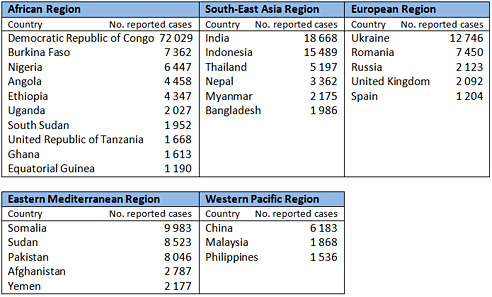Measles deaths reach record lows with fragile gains toward global elimination
6 February 2014 | GENEVA - New mortality estimates from WHO show that annual measles deaths have reached historic lows, dropping 78% from more than 562 000 in 2000 to 122 000 in 2012. During this time period, an estimated 13.8 million deaths have been prevented by measles vaccination and surveillance data showed that reported cases declined 77% from 853 480 to 226 722.
These gains are a result of global routine measles immunization coverage holding steady at 84%1 and 145 countries having introduced a routine second dose of measles vaccine to ensure immunity and prevent outbreaks. In addition to routine immunization, countries vaccinated 145 million children during mass campaigns against measles in 2012 and reached more than 1 billion since 2000, with the support of the Measles & Rubella Initiative.
Fragile gains
Despite the impressive gains made, progress towards measles elimination2 remains uneven with some populations still unprotected. Measles continues to be a global threat, with five of six WHO regions still experiencing large outbreaks and with the Region of the Americas responding to many importations of measles cases. The African, Eastern Mediterranean and European regions are not likely to meet their measles elimination targets on time. The Region of the Americas has achieved measles elimination and continues to maintain this status while the Western Pacific region is approaching its target.
Routine measles vaccination coverage is an important progress indicator towards meeting Millennium Development Goal Four3 because of its potential to reduce child mortality and widely recognized as a marker of access to children's health services.
Without improved immunization coverage both through routine services and mass campaigns, outbreaks will continue to occur, hampering efforts to meet global elimination targets and prevent additional deaths. The ability to contain outbreaks by improving routine coverage and, when necessary, implementing high quality vaccination campaigns requires countries to place a high priority on elimination goals and to invest heavily in health systems improvements.
Large measles outbreaks in 2012 by WHO region

The Measles & Rubella Initiative
Launched in 2001, the Measles & Rubella Initiative is a global partnership led by the American Red Cross, United Nations Foundation, U.S. Centers for Disease Control and Prevention (CDC), UNICEF and WHO.
The Measles & Rubella Initiative is committed to ensuring that no child dies from measles or is born with congenital rubella syndrome; reducing measles deaths by 95% by 2015; and achieving measles and rubella elimination in at least five regions by 2020. The WHO Region of the Americas has sustained measles elimination since 2002 and WHO Western Pacific Region is on track to reach its goal. All six regions have established measles elimination goals.
The latest data is published in this week's CDC Morbidity and Mortality Weekly Report and WHO Weekly Epidemiological Report.
The Measles & Rubella Initiative join others in celebrating World Immunization Week, April 24-30 to promote one of the world's most powerful tools for health – the use of vaccines to protect people of all ages against disease.
For more information please contact:
WHO, Geneva
Fadéla Chaib
Communications Officer/WHO Spokesperson
Telephone: +41 22 791 3228
Mobile: +41 79 475 5556
E-mail:[email protected]
UNICEF, New York
Karen Mah
Communications Specialist
Measles & Rubella Initiative
Telephone: +1 917 265 4603
Mobile: +1 917 412 6166
E-mail:[email protected]
1 Coverage with the first dose of measles-containing vaccine (MCV1) among children aged 1 year or, if MCV1 is given at age ≥1 year, among children aged 24 months.
2 In May 2012, 194 countries at the World Health Assembly committed to the Global Vaccine Action Plan (GVAP). Within GVAP is the commitment by the end of 2015 to reduce global measles mortality by at least 95% compared with 2000 and achieve measles and rubella elimination in at least five WHO regions by the end of 2020.
3 Reduce by two thirds, between 1990 and 2015, the under-five mortality rate. One of the MDG4 indicators is the proportion of 1 year-old children immunized against measles.